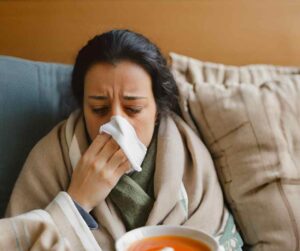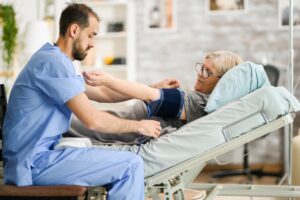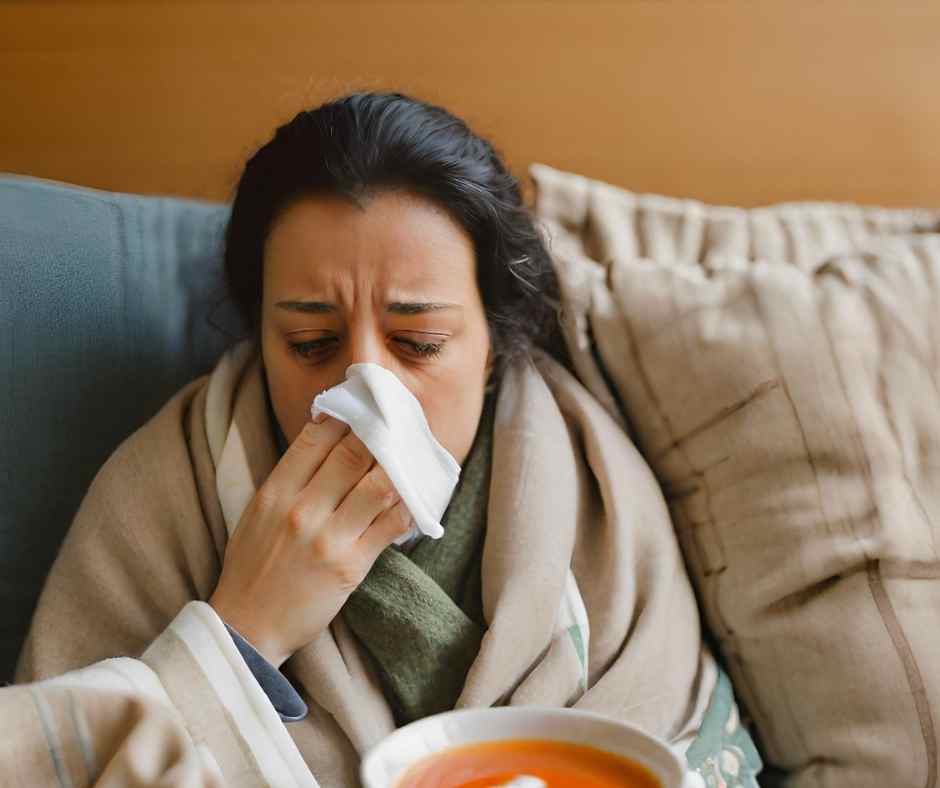COVID-19 came crashing into our lives with an official pandemic announcement in February, 2020. Our news media turned a natural infectious phenomenon into a political issue. In short order our society was asked to judge the “performance” of our then President in handling “this crisis”. The President’s intolerable narcissistic claims of success at each daily press meeting likely cost him the election.
I would like to explain how I think society responded to this pandemic with hysterical overreaction, resulting in “crossing the line”. The lines crossed are many. We have people judging others regarding personal health care decisions. We have businesses taking responsibilities that aren’t theirs. There are significant lessons to be learned as well.
With COVID-19, there are seven strains of coronavirus that infect humans. Four of these strains have been recognized as one of the 200+ causes of “the common cold “. I am aware of a PCR nasal test that will detect two of these common strains. I learned about the coronavirus family in microbiology in medical school. I recall telling my family in January of 2020 when this first began to break as a news story that this was a highly contagious family of viruses. There was no way we were going to be able to contain this bug. Due to the common strains infectivity and noting that there were cases outside of China already, the cat was out of the bag. We all now have seen the cycle of infection as we move past a full year’s since it transmission in the US started. The foreseen assessment of the facts on the ground seemed to have bypassed all the leadership and its “experts in science”. It was never a realistic goal to isolate the cases and cause this virus to stop spreading. That is a primary lesson for us to understand. It was wrong headed to pretend this was a reasonable policy to emphasize. Thankfully we did recognize that vaccinations would offer our best global strategy.
Early on many can recall people clamoring for toilet paper and hand towels. People were reacting as if there was some kind of clandestine nuclear holocaust around the corner. I kept asking myself why toilet paper and paper towels? Where people expecting to have profuse diarrhea or were they already planning to use these materials as “protective masks”. Perhaps many expected that they would be asked to lock up in their homes. Hysteria was rapidly rising. Then came the “emergency measures” from our various state government agencies. By using this infectious pandemic as an excuse for emergency, government measures were taken to “lockdown” persons and businesses. This happened, however, after businesses like the NCAA and NFL chose to close down shop out of fear of liabilities. I remember discussing with friends that things just weren’t adding up. Most would not admit it but people were wondering if this overreaction was some kind of “test” of governance over the United States citizens. Society became unglued over a microscopic respiratory virus pathogen recognized as being in the family of coronavirus. Government and media reactions of hysteria promoted society hysteria. Is this an emergency because perhaps governments and government labs have culpability here? Circumstantial evidence is mounting that favors that possibility. This allowed one bad decision after another to follow.
A recent book by economist author Ryan Bourne explains that this pandemic affords all of us a chance to see how life and economics is about trade offs. Using the pandemic and the ensuing behaviors of individuals, businesses and governments, he helps us understand that if provided information all interested parties make rational decisions, many conflicting depending upon self-interest. In an early chapter he points out that businesses and people began social isolation BEFORE governments dictated it. For me one of the first economic lessons we should have learned is that hospitals and other health care suppliers should not be using last minute inventory management of their supplies. Getting caught flat-footed with insufficiency protective gowns and N95 3M face coverings resulted in major panic.
With this acute supply crisis, our government learned we had supply chain major choke points in critically important items resulting in a national security issue. The reality that our institutions didn’t have adequate supply of OSHA compliant protection for its health care workforce is what really tipped the system into the next most harmful decision. SHUT DOWN THE HOSPITALS AND OUTPATIENT ACCESS. The decision that in my view was the absolute opposite of what should be done in an infectious outbreak was to shut down hospitals and medical offices. Never in my career have a I witnessed the turning of a health care oasis into a desert overnight. For weeks I couldn’t order diagnostic x-rays. CT scans were out of the question due to fear of having a potentially infected person show up at the facility. Our CDC wanted to talk to us about using make-shift face masks for the public, stay at home if sick and only call on the hospital if you were blue from lack of oxygen. The shutdown of the global economy is resulting in shortages of all sorts. Now in the news we seemed surprised that all things produced are costing more money or not available.
For two to three months, patients were denied the opportunity to be physically examined and assessed to see if early outpatient medical management could help them avoid turning blue and having to show up in the emergency room. I won’t even get into the delay of care and higher heart attack deaths etc. The CDC guidance in tandem with some governors and hospital systems, silenced physician autonomy in deciding patient management of COVID-19. We can’t talk about nor consider hydroxychloroquine, ivermectin or seeking other repurposed compounds. There were no outpatient management recommendations from our governing health care administration. Thankfully now we do have monoclonal antibody infusion therapy (passive immunity). It turns out at this point this OUTPATIENT treatment offering is likely the best therapeutic option we have. Using the remdesivir and pooled plasma for inpatients has marginal if any actual statistical mortality benefit but yet this is still the only “option” in the hospital setting.
Another remarkable observation that I have witnessed is how businesspeople seemed to have assumed that they are responsible for testing and medically managing their employees. Since when is it business’ duty to invade your private life and health information? To highlight the level of national hysteria we are actually having serious consideration of proof of vaccine in order to navigate in society. Now employers are seriously suggesting that it should be an OSHA requirement that employees be vaccinated in order to work. This folks is just hysterical thinking. It is a ludicrous position to consider knowing that this is likely to be a cyclical smoldering respiratory pathogen of the same consequence as innumerable other pathogens we encounter routinely as part of living.
Without any understanding of PCR technology we have had mass testing of individuals who are not sick in any way with the inevitable outcome of a positive test result. Many businesspeople called me for advice after they had opened up this Pandora’s box. They wanted to know what they should do with this information. They wanted guidance on whether or not employees should remain at work. They wanted to know whether or not they should shut their business down. Time and time again I had to explain the concept of a false positive test. Understanding pretest and post test probability in proper application of testing is definitely not in the purview of your average business owner. The best replies I could give them was that I advised they not test people at all and that further if any question of testing is considered their employees should be referred to their physician.
And now for the elephant in the room- the issue of masks. Masking in public- Heaven forbid you might spread illness to a stranger, but by all means give it to your family! Recall that one of the earliest panic situations stemmed from lack of protective personal equipment for health care workers. Those health care workers included yours truly, the ambulatory physician’s office. More importantly (due to high incidence of actual infective cases) and more relevantly, this includes the doctors and nurses working in emergency rooms, hospital infectious wards and especially the intensive care unit.
From one of the original case series reports of the incidence of hospitalized COVID infection spread, properly used fully protective equipment barriers including and 95 masks, eye/face shields, gloves, and disposable gowns resulted in only two ICU acquired cases of approximately 100 hospital spread infections. Clearly properly used and meticulously adhered to protocol for protection of respiratory infections in institutions significantly reduces risk to the health care providers.
To the rest of the hospital- there have been numerous studies in the past that have documented that even in a professional setting spread of influenza and other respiratory viruses occur in hospitals where patients who are sick are being cared for. This is including studies using N95 masks as well as surgical masks. Nonetheless, even with careful partial protection the incidence of infection rises significantly within the hospital. This is a main argument for prioritizing vaccinating hospital and other institutional health care workers.
I would submit that the idea of public masking as an effective way to lower infection rates from a highly contagious respiratory virus is just a few steps short of futile. Particle analysis of mask effectiveness performed in aerosol chambers have shown that N95 masks do block greater than 95% of particles under the size of 5-10 microns. Additionally, surgical facemasks allow 35-40% of such particles to arrive on the wearer’s breathing side of the mask. While one might conclude that this is proof that masks not of N95 quality are “protective”, I would submit that a 35-40% penetration rate is not an acceptable level of protection. If that were an acceptable level of protection we would not need an OSHA approved N 95 mask for respiratory infection and particle protection. To those that are going to write scathing replies to this blog about how it is malpractice to not force people into masks and deny their effectiveness my reply is 35-40% particle penetrance within five minutes simply is not protection of any meaningful amount. Further, people don’t wear them effectively and the odds of exposure in the random environment is very low. Placing such blind faith in such a ridiculous maneuver is perpetuating hysterical thinking.
Another tragic outcome of zero tolerance for risk was entire swaths of our society being mowed over in the interest of “protecting” everyone. I personally witnessed more than one patient suffer alone and even die with no family allowed to be with them. How many weeks and months did elderly people who paid premiums for assisted and skilled nursing care get holed up in their rooms and fed boxed meals while staring at the four walls for companionship? These patients are still coming in and talking about this horrible experience.
Thankfully by historical measures while this virus is contagious its not that virulent. If we look at reported case mortality data it appears that in the United States the mortality rate is 1.8% across the general population. If however we also recognize that as many as 5-10 times as many diagnose cases have not been documented then we are looking at about a 0.2% mortality rate. Influenza on average carries about a 0.1% mortality rate. This begs the question, is a 2-fold increase risk of death from a pathogen sufficient to accept dictates from government on managing this “crisis”? Are we still in an emergency situation? Does the emergency authorization of vaccine still apply? I am very empathetic to our national consciousness of concern early into this process but as the facts unfold, I think it is time for us to question further decision making by our authorities and equally from businesses.
People’s health is very serious and individuals make choices daily about the risks that are inherent in life. I see no evidence nor compelling logic that suggest it is anyone other than the individuals responsibility to decide how far they wish to take things to minimize their chances of getting ill from a respiratory illness. With the improving outpatient care management and effective monoclonal infusion therapy, the COVID-19 pandemic should not give society license to force any chronic change in our prior policies and procedures for living in the 21st century.










